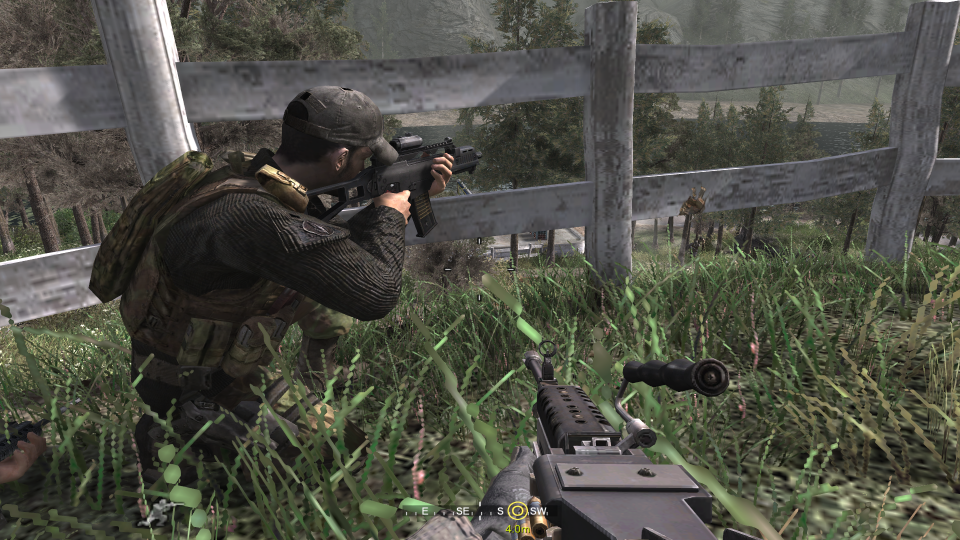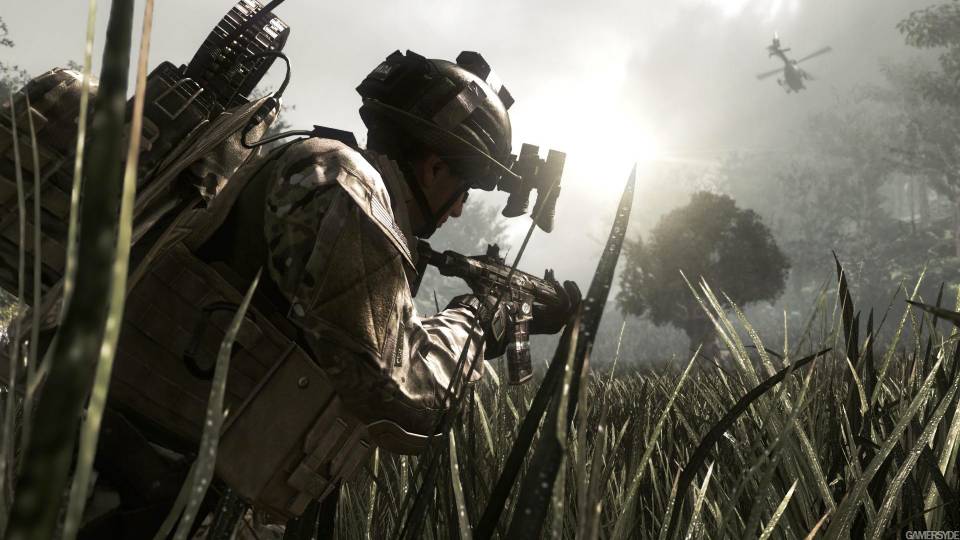What Defines "Next Generation" Graphics?
By pythagreon 23 Comments
Hey folks, new guy here. Seems like the next generation of consoles is a bit of a hot topic. On thing that really surprised me, even more than all of the indignation over what are at this point little more than rumors about the Xbone, was the response to the new Call of Duty game. Now, I do agree that things don't really seem to be evolving on a gameplay side, but it's not really sensible to assume any of that because we didn't even see gameplay really. In fact, we barely saw the game at all. It was a lot of wireframes and renders.
I usually use IGN as a place to go laugh at ridiculous rumor posts and the awful community, and to keep up on any news that they might catch onto first. I spotted an article titled "Call of Duty: Ghosts Isn't Breathtakingly Next-Gen and That's OK" and honestly, I was surprised to see something so reasonable posted to IGN. Because, while I could certainly see why everyone was saying that they weren't blown away by the engine improvements, I also didn't think it looked bad by any stretch. I mean, early 360 games looked bad in a lot of cases. Really bad. Tenchu Z looked like a PS2 game. Perfect Dark looked like... I don't even know what it looked like, honestly. Kind of looked like the sort of fake horrible video game you'd see on a show like NCIS, actually. And those games weren't targeting 60fps, as I remember.
But Call of Duty Ghosts? It looks fine. Now, compare it to a PC game, and obviously you'll be disappointed. Compare it to that spectacular supposed Dragon's Dogma PS4 demo, and yes, you'll be disappointed. Because those games are either running much better hardware, or targeting a very different point on the spectrum.
Read the comments on that article. There are a few folks seeing reason, but most of them are saying that there hasn't been any change. One comment compared the Call of Duty engine to Frostbite, saying that there were almost no changes to the Call of Duty engine over almost a dozen games, but that Frostbite has evolved hugely.
So I thought "Hold up, lets think back to where these various games started."
So, we come to two games. And I'm going to stick to consoles here because it's really the consoles we're talking about, so don't bring the PC versions into any of this (even though I'll be using some shots of the PC versions set at approximately console settings in cases where I couldn't find a good comparison). The first game to really start the current generation of Call of Duty tech: Call of Duty 4: Modern Warfare, and the first game made with Dice's "Frostbite" engine: Bad Company.
Think back to playing Call of Duty 4. Think back to the visual fidelity of that game, the talk of the resolution the game was running at (confirmed to be 1024x600, by the way. Pretty damn low, isn't it?), and the framerate that the game was running at on consoles. At the time, especially for how well it ran, the game looked fine. Didn't blow anyone away really, and obviously in still moments it couldn't hold up to the better looking 30FPS games of the time. But it looked fine for a 360 game at the time.
Time hasn't been kind to Call of Duty 4. In fact, even when running on a very powerful PC with as many fancy doodads as you can cram into it, it still looks roughly like "a hairy ass."

This is the game running at 1920x1080, with 8xSSAA for transparencies and 8xMSAA. Forcing nVidia's Ambient Occlusion at Very High Quality. All in game settings as high they'll go.
Here's an approximation of what it looks like on the 360:

Running on the PC with medium settings, accurate MSAA (2xMSAA) and at the correct resolution (1024x600) to match the 360.
Not much of a looker in either case, is it? The textures are downright messy, especially that grass, which if not for the interpolation I'm guessing would look just like the grass in the 16bit Minecraft skin I use.
Now, lets compare that to the newly announced Call of Duty: Ghosts.

Notice: the grass is so detailed it has actual, well, details. And as for the textures on this guy's uniform? That Multicam's larger features looks better than some of the smaller details on the MW1 character. Oh, and did I mention the part where while Call of Duty 4 was displaying 614,400 pixels per frame, Call of Duty Ghosts appears to be running at a whopping 2,073,600 pixels per frame. Woah. Now some quick math: 2,073,600 / 614,400 = 3.375. That's right. almost 4 times as many pixels on screen per frame. That means edges will be cleaner, sharper, and smoother. It means that texture detail will be noticeable at greater in game distances and the distance you can make out objects will be greatly increased as well. Do a little math to find the difference in pixels per second, and you'll be flabbergasted. So much so that you wouldn't likely be able to even finish the rest of this blog, so I'll leave that to you!
Now, I know some folks are bound to point out that this "nearly 4 times the resolution" talk is a bit misleading. So let's split it up into vertical and horizontal because those ratios are a bit more important in things like aliasing.
So then we have 1920 / 1024 which is 1.875. That's still a nearly doubly wide image, and a pretty big improvement especially on the larger screens consoles are usually attached to. And 1080 / 600 = 1.8, also nearly double. I'm not saying edges will be twice as smooth and clean and crisp: because there's more to it than just "Hey, more pixels means my eyes see a less jagged edge." Even without Anti-aliasing, the image will look cleaner and smoother. Here's a very simple exaggeration of what causes jagged edges in real time rendering, and how much something like doubling of the density of pixels can do:
More pixels also means more data for Anti-aliasing to sample from and to use to do it's magic. It also means it needs to do less magic to get a similar amount of smoothing. Below I'm showing Call of Duty 4 at various resolutions, blown up to match the full 1920x1080 resolution. This is with no transparency AA and 4xMSAA, which is probably comparable to what many next gen games will use.
As you can see, the resolution can play a pretty big role in how the image looks without any correction for aliasing, as well as benefiting a more from that correction because it's closer to being seen as just a smooth line and because there's more data to work with.
And there's likely more we don't really know much about. Compute based effects, for example, could play a big role in the next generation, and we don't have a great idea on how the new Call of Duty might use these. Chances are, explosions will look more wicked, and even little things like bullet impacts will have more bite as they tear up the environment and spew debris. They may not be on the same level as Battlefield 4's volumetric fireball of awesomeness, (or maybe it will be, compute is one of those weird untapped things that we really have no idea where it might take us, which is exciting!), but they will be above and beyond the particles of MW1 that don't even collide with the floor.
Hopefully this little comparison will help folks see through the rose tinted glasses to remember A) just how limited the hardware of the PS3 and 360 are, and B) just how much "little" things can matter, especially resolution or framerate. I know people were underwhelmed. And I can understand why. But put this into a context that actually makes sense. Remember what MW1 looked like, and look at how much better Call of Duty looks on the same hardware, many years later. The faces look not only exponentially better than they did in MW1, but they also actually look great just for this generation in general. I've included a couple of shots of what MW1 can look like on a modern PC with all of the bells and whistles, including SSAA and other driver forced features. Here are a few shots of what they've done since then: Black Ops II. It's an excellent looking game, and still incredibly easy to run. Even running at 2880x1800, with 4xTXAA and everything at max settings, the game runs flawlessly, and looks very sharp.
As you can see, the game looks so very much better than previous entries in the franchise. The faces look not only very sharp, but extremely expressive. Very few games do actual expressions beyond smiling and grimacing, let alone animate the facial expressions for specific events. The environments are much more detailed, and look at that grass! It looks smooth and grasslike, instead of like a bunch of weird ovals! But it still doesn't compare to the new Call of Duty, which will have much better textures, higher polycounts, and hopefully a few other goodies for us. And if not, eventually they'll get to the Black Ops 2 of the next generation, that perfects the tech on that hardware, and I'm sure it'll look impressive as hell for a game designed to run at 60fps on 6 year old hardware (or 8 year old for this generation).
So come on folks, don't be so cynical and bummed out. Truth is, what little we've seen of the Ghosts engine is just fine. Especially knowing the increases in the "numbers" like resolution and the high framerate. It won't be that ridiculously unbelievably believable Dragon's Dogma thing, sure. But it'll look fine and play the way a Call of Duty game should.
For those concerned about the gameplay, it sounds like they are trying to expand upon the "choice" of Black Ops II to provide for a less linear experience. So if you're not totally sick of Call of Duty, don't lose hope that this one won't catch your attention. We have no idea what's coming. It might be awesome, might be boring, might be somewhere in the middle. But lets stop pretending we know anything more than we do, slow down, and consider things in the proper context. Using reason and logic, not gut reactions.
Anyway, if you read this and enjoyed it or disagree or like pancakes or whatever, let me know! This was really just me passing time because I couldn't sleep, so it's probably a bit rambling. I'd love to hear what you guys think about the next generation and if you agree with me that most reactions to these things end up being hyperboles born of not thinking past the first gut feeling.













Log in to comment